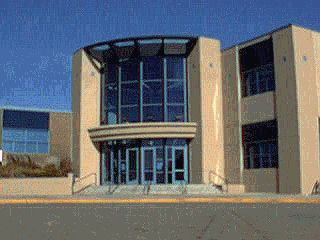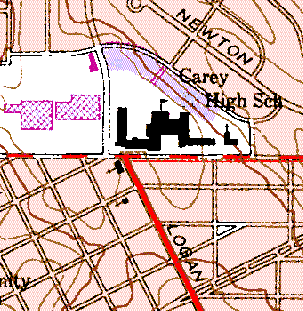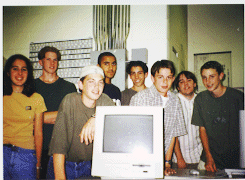

In order to address
this concern, this research seeks to: (1) describe the geographic
and curricular extent to which GIS technology and methods are being implemented
in secondary education in the United States, and (2) explain why
and how GIS technology and methods are being implemented.
Five hypotheses were tested in this research: (1) Social, educational, and political forces limit and encourage the implementation of GIS technology and methods to a greater degree than do the technological forces; (2) instructional methods that teachers use with GIS are more closely aligned with the key tenets of modern educational reform than methods they used before the introduction of the technology; (3) the use of GIS strengthens inquiry-based, standards-based learning, rather than traditional locational skills of geography; (4) the incorporation of GIS technology and methods into the secondary geography curriculum fundamentally changes the manner of teaching, learning, and meaning constructed in the classroom; (5) GIS technology and methods are implemented in the secondary curriculum primarily through the efforts of individual teachers, rather than via a systematic, national educational agenda.
Research in educational GIS is critical to the improvement of student-centered techniques in geography education. These improvements will result in better-equipped students and will force significant changes on the entire university geography and science curricula. This research examines the influences of GIS on a core institutional structure of society's schools. This examination has been identified as one of the top ten research priorities by the University Consortium for Geographic Information Science (UCGIS 1996).
A growing number of studies cite the potential contribution of GIS to education.
"Geographic information systems make the process of presenting and analyzing
geographic information easier, so they accelerate geographic inquiry" stated
the participants of the Geography Education Standards Project (1994: 45).
GIS, because of its suitability for constructivist, inquiry-based methods
of analysis, has great potential as a tool to aid the acquisition of standards-based
knowledge and skills. Bednarz (1995) illustrated the clear linkages between
GIS and constructivist learning: Students "construct" knowledge through
building databases and maps, and explore spatial relationships through
mapping. Hill (1995) identified technology as "clearly within the scope
of issues-based geographic inquiry." Projects based on GIS technology
require students in groups to identify resources, gather data, and test
data. The Geography Education Standards Project team stated that "the power
of a GIS is that it allows us to ask questions of data" (1994: 256). This
inquiry-based method has been highly advocated because it poses questions
and proposes answers about the real world, which are then tested with real-world
data.
 Other studies document the utility of GIS at specific schools (Hamilton
and Paul 1997; Friebertshauser 1997), schools where students have won presidential
awards (McGarigle 1997), or where the school is now providing GIS services
to city government (Environmental Systems Research Institute 1995 and 1997).
GIS has also been demonstrated as suitable for young students (Fitzpatrick
1997). GIS has been recognized as an important addition for school-to-work
programs because of expanding and steady employment opportunities for those
skilled in GIS.
Other studies document the utility of GIS at specific schools (Hamilton
and Paul 1997; Friebertshauser 1997), schools where students have won presidential
awards (McGarigle 1997), or where the school is now providing GIS services
to city government (Environmental Systems Research Institute 1995 and 1997).
GIS has also been demonstrated as suitable for young students (Fitzpatrick
1997). GIS has been recognized as an important addition for school-to-work
programs because of expanding and steady employment opportunities for those
skilled in GIS.
A variety of organizations,
institutions, and projects have combined to foster the progress of GIS
in primary and secondary schools. In 1994, the first conference on educational
GIS began a national dialogue on research needs and implementation strategies
(Barstow et al. 1994). The National Center for Geographic Information and
Analysis (NCGIA) conducted research on GIS in secondary schools through
the Secondary Education Project and found increasing national support (Palladino
1992 and 1994). The National Council for Geographic Education and the National
Geographic Society are sponsoring K-12 GIS outreach training and programs.
Universities are increasingly involved in secondary geography education,
particularly due to the network of state geography alliances established
in universities.

Despite the interest
and the claims, GIS has been acquired by only an estimated 2% of approximately
106,000 K-12 schools in the United States. Crechiolo (1997) discovered
that adoption barriers included limited access to hardware and software,
insufficient preservice and inservice training, and the paucity of appropriate
teaching resources. Donaldson (1997) found adequate computer stock and
funding in 250 Ohio high schools, but an absence of GIS awareness and a
subsequent lack of use. However, these studies are still too few and regional
to provide sufficient understanding of the structural and pedagogical issues
affecting the incorporation of the technology and methods in geography
on a national scale.
A mail survey was conducted to describe and explain the extent to which GIS technology and methods are being implemented. A survey pilot test was administered to two groups during summer 1998. The first group consisted of GIS educators from the Environmental Systems Research Institute (Esri), Clark University's Idrisi project, and MapInfo Corporation. This group was chosen because they are among the most active in the nation in training teachers and developing GIS-based lesson modules. The second group was teachers who participated in the first National GIS summer institute, chosen because they represent a similar population as the sampling frame. The respondents in these two groups commented on the survey's length, interpretation, wording, and instructions.
The sampling frame for
the survey was selected from the set of high school teachers that own ArcView,
Idrisi, or MapInfo. The survey was mailed to a random sample
of the schools in the sampling frame. Because the goal was to understand
the attitudes and strategies of those actually using GIS software, the
survey was directed to that teacher in each school. A total of 1,520 surveys
were mailed.
As of this writing,
27% of the surveys have been returned. Based on a sample of these surveys,
several trends and characteristics are clear. First, the number of high
schools in the three software listings indicated that despite the relative
maturity of GIS in government, business, and university research, GIS has
not made significant inroads in K-12 education in terms of the number of
schools involved. Over 90% of survey respondents teach in public high schools,
with 60% of the respondents in schools between 500 and 1,999 students,
dispelling notions that GIS is only being adopted in small, elite, private
schools. The class sizes of the teachers using GIS are also standard, with
the majority between 21 and 30 students.

Unexpectedly, most
of the teachers who have adopted GIS are veteran teachers - - 61% have
been teaching at least 15 years, and 42% have been teaching at least 20
years. Only three teachers (N=118) are in their first three years of teaching.
Furthermore, over 72% of these teachers have at least a master's degree
or equivalent. Thirteen teachers have a doctoral degree. These are motivated
teachers who attend several educational conferences each year.
GIS is being incorporated within the traditional secondary educational curriculum. Less than 10% of the GIS instruction is being done in nontraditional classes such as technology education, agriculture, and GIS classes. The student-to-computer ratio in these classes indicates that students generally have poor access to computers. In 48% of classes, a 10:1 ratio exists. In only 27% of classrooms is the ratio less than 3:1. This means that teachers will have difficulty in incorporating a computer-based tool such as GIS.
Surprisingly, GIS is much more frequently adopted by science teachers (52%) than geography teachers (28%). Could it be that the science teachers have traditionally been more willing to experiment, particularly with an open-ended system such as GIS? Or, perhaps these findings confirm Wardley's (1997) Michigan study, where 63% of the social studies students did not have access to computers, but the science students had better access.
How are these teachers becoming trained in GIS? The fact that 28% indicated that they trained themselves confirms the suspicion that these teachers are "trailblazers," particularly commendable with a complex software package such as GIS. Indeed, most respondents indicated that they either have spent no or few hours in formal training classes. These teachers are developing the modules, gathering the data, and resolving some of the problems for the bulk of the educational community to follow. Educational inservices provided the most frequent training (32%), although GIS software companies, particularly Esri, provided 15% of the training. Geographic alliance-sponsored training was cited only 12% of the time, not surprising, considering that most of the respondents are science teachers, not geography teachers. Still, should not the geography community step up to the challenge and provide leadership in training the educational community in a tool so important to its discipline?
In only one-quarter of the schools surveyed is GIS used by more than one teacher. This confirms the hypothesis that most GIS-based lesson modules are currently built by individual teachers working in isolated classrooms scattered across the country.
GIS is a recent phenomenon in secondary education. Only two teachers indicated they were using the tool in 1990. Over 40% indicated they have begun using it only in the past year. However, the delay between the date that the software was obtained and the date that the teachers began using it in the curriculum belies a set of limitations to the use of GIS. In 30% of cases, a one-to-two year delay was noted, and in nearly 20% of cases, at least three years' delay occurred. Furthermore, 33% of respondents to the questionnaire indicate that they are still not using GIS. Over half of the respondents are using GIS only as a canned demonstration, or at the most, use it to prepare maps for a traditional lesson. Only 18% use it in more than one lesson in more than one class. In 73% of surveyed schools, only one-tenth of the student body is exposed to GIS. Clearly, GIS is not the type of tool that a teacher can implement into the curriculum as soon as it is obtained, nor can it be easily expanded in the curriculum. Why?
GIS is an exploratory tool, one that appears upon loading as a series of blank windows on a computer screen. The software requires the user to make the choices about the type, the geographic extent, the scale, and the amount of data to analyze. Blank screens are daunting to the first-time user.
Repeatedly, teachers cited five items that would enhance their use of GIS in teaching. Time was named, indicating both the complexity of the software as well as the dearth of GIS-based lesson modules. Despite the presumed utility of GIS tools, a gulf remains between the capability of the tools and the implementation of the tools. The number one recommendation from the first national conference on educational GIS was the need for the development of GIS-based lesson modules (Barstow et al. 1994). The need still exists today, but is being met as the library of lesson modules grows.
Teachers stated that they require "user-friendly" GIS software, and training was cited as an ongoing need. Many teachers remarked that the training they received was too general; not tailored for the specific needs of the educational community. Finding and funding hardware robust enough to manipulate digital geospatial data is another limit to implementation. A critical component is the involvement of the computer laboratory manager. The manager's involvement in troubleshooting hardware and software problems allows time for the content teacher to design lessons.
If GIS cannot be quickly mastered and used in the curriculum, why are teachers still willing to invest in making GIS implementation a success? Indeed, the teachers are enthusiastic about the technology. Over 68% say they plan to increase their use of it in the next year. These teachers are spending their own time learning the software: 55% say they spend at least one hour per week outside of class time with GIS. This is startling, especially given the fact that most of these teachers have been teaching at least 20 years.
Teachers most often name enhanced student motivation, integration between subjects, and enhanced learning as benefits of implementing GIS. They less frequently indicate that the tool helps teach educational standards in their discipline, or that it provides employment skills.
GIS is being used in
the curriculum in reformist ways that involve the student in open-ended
projects that involve real-world data, often about their own communities.
More than a set of computer tools, GIS entails a specific method
for analyzing the world. These methods, more than the tools, make it
attractive to teachers and administrators. GIS-based instruction is best
done with groups and projects, and therefore lends itself to inquiry-based,
project-based learning. Since students using GIS gather and analyze real-world
data, it seems to encourage relevant learning, based on the teacher's responses.
The authors of the national geography standards referred to GIS as a "process"
(Geography Education Standards Project: 45). Thus, GIS is not only a technological
tool, but a method of instruction in the application of spatial data to
solve problems. The lessons cited by the teachers, such as analyzing data
from radio-telemetry of black bears to determine habitat, demographic analyses
of neighborhoods at Boulder
High School, and analyzing a 22-month crime data set from a local police
department, are not traditional, place-name, location-based geography instruction.
Therefore, even though GIS is being used by few schools and in few lessons,
where it is used, teachers perceive it as providing significant
benefit. Measuring this benefit will comprise the next phase of this
research.
Most teachers are familiar with computer technology, and are willing to try new methods of instruction if they perceive that teaching and learning will be improved. This research provides insight to the forces hindering these teachers from using GIS technology, a tool that has been repeatedly identified as a major tool for educational reform. Yet, significant advances in GIS-based education have occurred from a small but growing number of teachers enthusiastic about the tool.
The hypotheses that social, educational, and political forces limit and encourage the implementation of GIS technology and methods to a greater degree than do the technological forces seems to be supported by the first set of survey responses. These forces were mentioned much more often than the hardware, software, and data issues. The hypothesis that GIS teachers use instructional methods more closely aligned with modern educational reform than methods they used before the introduction of the technology was also supported. Furthermore, GIS is being used for inquiry and standards-based learning, rather than traditional locational skills of geography. The hypothesis that incorporating GIS fundamentally changes the manner of teaching, learning, and meaning constructed in the classroom seems initially supported. The hypothesis that GIS technology and methods are implemented in the secondary curriculum primarily through the efforts of individual teachers, rather than via a systematic, national educational agenda was supported by the survey.
This research provides insight so that educators will recognize how to use geographic information systems within the context of a new educational paradigm, to make teaching and learning more relevant, effective, and exciting.
Barstow, Daniel, Michelle Decker Gerrard, Peggy M. Kapisovsky, Robert F. Tinker, and Vickie Wojtkiewicz. 1994. First National Conference on the Educational Applications of Geographic Information Systems (EdGIS) Conference Report. 27-29 January 1994. Cambridge, MA: TERC Communications, 139 p.
Bednarz, Sarah W. 1995. Researching new standards: GIS and K-12 geography. GIS/LIS '95 Conference Proceedings. Nashville, Tennessee, pp. 44-52.
Crechiolo, Angela. 1997. Teaching secondary school geography with the use of a geographical information system (GIS). Master's Thesis, Wilfrid Laurier University, 120 p.
Donaldson, Dan. 1997. GIS in public high schools: An Ohio case study. Master's Thesis, Kent State University.
Environmental Systems Research Institute. 1995. Explore Your World: GIS in K-12 Education. Video. Redlands, California: Esri, Inc.
Environmental Systems Research Institute. 1997. Zeroing In: Applications of GIS in the Community. Redlands, California: Esri, Inc.
Fitzpatrick, Charlie. 1997. Can young students use GIS? ArcNews 19(3): 33. Fall.
Friebertshauser, Reinhold. 1997. Higher learning: GIS in nontraditional curriculums. Geo Info Systems 7(4): 18-26. April.
Geography Education Standards Project. 1994. Geography for Life: National Geography Standards 1994. Washington: National Geographic Research and Exploration, 272 p.
Hill, A. David. 1995. Projections and Perceptions--Editorial Comments: Learning for the New World of Work Through Geographic Inquiry. The Geographical Bulletin, 37(2): 65-67.
McGarigle, Bill. 1997. High school students win national awards with GIS. Government Technology 9(7): 1, 48. July.
Palladino, Stephen D. 1992. GIS in the schools. Workshop Resource Packet, Technical Report 93-2, Santa Barbara, California: National Center for Geographic Information and Analysis.
Palladino, Stephen D. 1994. A role for geographic information systems in the secondary schools: An assessment of the current status and future possibilities. Master's Thesis, University of California, Santa Barbara.
University Consortium for Geographic Information Science (UCGIS). 1996. Research Priorities for Geographic Information Science. Cartography and Geographic Information Systems, 23(3), pp. 115-127.
Wardley, Sonia J. 1997. GIS in high school
geography education: A feasibility study. Master's Thesis, Western Michigan
University.
Department of Geography
University of Colorado
Campus Box 260
Boulder CO 80309-0260 USA
http://ucsu.colorado.edu/~kerski
joseph.kerski@colorado.edu
303-202-4315 Tel
303-202-4137 Fax